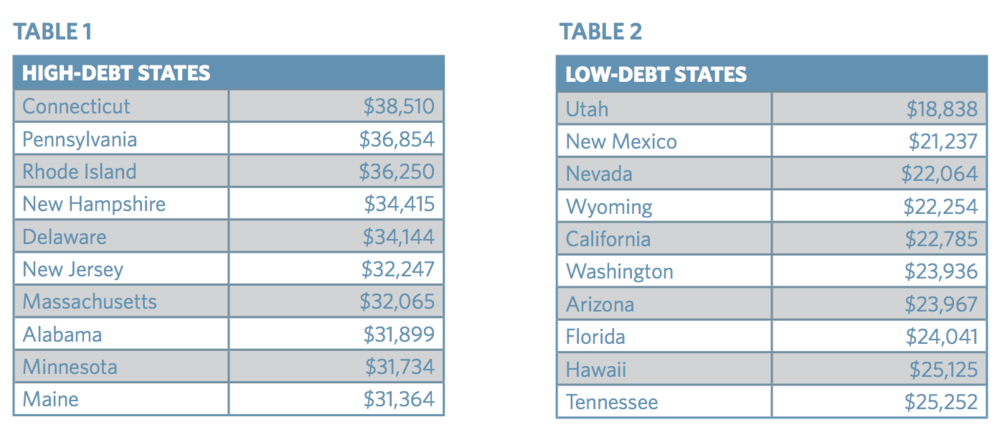By: Taylor Giangregorio
Connecticut students are facing the highest amount of college debt in the United States, according to the 13th annual report conducted by the Institute for College Access and Success.
State averages for students in debt after graduation range from as low as Utah’s average of $18,850 to Connecticut’s $38,500, which is more than twice as much. The following table found on page eight of TICAS’s report, compares states with the lowest and highest averages of student debt.

The findings in the report show that 57 percent of Connecticut higher education graduates in 2017 had some form of debt. However, there was only a one percent growth in the average debt from 2016 to 2017, the only increase since 2012. Student borrowers owed an average of $28,650 in 2017, yet the average Connecticut borrower owes almost $10,000 more. Why is it that over half of student graduates in Connecticut are left with a degree in one hand and piles on piles of student loan agreements and bills in the other?

University of Hartford junior, Ryan Martin
Although the average debt is stable across the country, students like Ryan Martin, a junior at University of Hartford, still have to come to terms with the cost of their education.
“When I took my student loans out for the first time, this crushing pressure set in as I looked at a number that I can’t even fathom being able to pay off,” said Martin.
While the average student debt collects at a steady rate, data shows that the burden is increasingly falling on parents. As students seem to hit their limits on federal loans, Federal Parent PLUS loan debt has increased 19 percent from the 2011-12 academic year to 2015-16, according to student loan expert Mark Kantrowitz.
Martin shares the encumbrance of college debt with his parents.
“I don’t think it’s fair that my own education puts my parents in a tricky spot. My parents have already given me enough. Now they have to jeopardize their credit just to put me through school, so I can end up with a decent job and a fulfilling life.”

Alexis Ferrara, Quinnipiac University senior
Quinnipiac senior Alexis Ferrara chose to attend school in Connecticut based on the success of Quinnipiac’s physical therapy program.
“It’s frustrating to know that Connecticut has the highest average of student debt. I still have another three and a half years and I know the loans are inevitable.”
Ferrara not only has to worry about undergraduate fees, but also will face the financial strain of the Doctor of Physical Therapy program.
“It’s almost a win-lose situation. You either spend a fortune to go to a school with one of the best programs or you go to an affordable school with an average program.”
The following interactive map, created by TICAS, explores student debt data by state and college based off of the full report, Student Debt and the Class of 2017.
To reduce debt burdens, states are creating policies to moderately alleviate students of financial distress. Some states, including Connecticut, have adopted a student loan borrower bill of rights. This policy properly enforces servicers by requiring them to be licensed in the state, properly inform borrowers and process payments, and allows students to provide feedback.
The Pennsylvania Higher Education Assistance Agency (PHEAA) a firm that manages federal loans, sued Connecticut’s department of banking and the federal Department of Education in regard to the state’s student loan laws.
The suit concerns whether or not the state should have jurisdiction over the Department of Education and student loan companies. Student loan companies argue that the contracts are issued with the federal government, and therefore should be overseen by the latter.
PHEAA, which services 100,000 loans in Connecticut, claims that the state has asked the organization to provide data about complaints made to the federal government in order to keep its license. PHEAA claims that the Department of Education bans companies from providing such data, including sensitive information about borrowers; and complying to the state’s request would violate federal laws.
State officials see the regulation of student loan providers as their responsibility.
Matthew Lesser, a state representative heavily involved in enforcing student loan regulation, said, “Connecticut is going to vigorously enforce our laws” in an article for MarketWatch.
The outcome of this case could potentially stretch far beyond the Connecticut state line. The District of Columbia and states such as California, Virginia, and Washington enforce a bill of rights for borrowers similar to Connecticut.
Adam Minsky, a student loan lawyer, believes that state regulation is an integral part of consumer protection.
“The ruling in this case has the potential to affect how other states regulate student loan servicers,” said Minsky in article for Student Loan Hero. “If the court rules against Connecticut, that would hinder the ability of states to regulate the private companies operating in their borders.”
Note to the reader: HQ Press reached out to TICAS for comment and did not receive a response.